
Poison -arrow frogs: Their fatal attraction!
There may be many among you who love and admire the most popular frog
in the entertainment world - Kermit the Frog, who plays a key role in
Sesame Street. Today, we are going to feature some of Kermit's cousins.
However, they (or at least a few of them) are not as harmless as Kermit
and other members of his family.
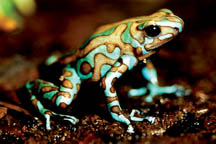
The frog species we feature today are found only in the rainforests
of South and Central America. They live mostly on damp leaf litter. Even
though these particular species of frogs are called poison-arrow frogs,
arrow-poison frogs or poison dart frogs, not all are actually harmful.
In fact, out of around 170-200 species so far identified, only a small
number of frogs are harmful to animals and humans.
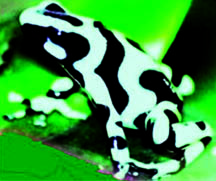
One of the deadliest is the Golden Arrow-poison Frog which belongs to
the Dendrobatids family. The skin secretions of the poison-arrow frogs
are believed to be one of the most powerful animal venom discovered.
Even a small amount of this poison is considered fatal. It is this
poison, which for centuries the South American Indians have been using
on arrow tips, that have earned the entire family of frogs the deadly
name, even though most are actually non-toxic.
The venom from certain species of poison arrow frogs can easily
result in muscular paralysis and has been of particular value to the
American Indians hunting small mammals high in the forest canopy. The
poison from one Golden Arrow-poison Frog, the most deadly of all
amphibians, is enough to be used on about 40 arrows.
Appearance
Poison-arrow frogs, although very small are beautifully coloured and
attractive in appearance. Most are not more than one to one and a half
inches in length. Many of the frogs have contrasting colours such as,
yellow and black, iridescent green and black, bright orange and even
blue.
They either have spotted patterns or striped patterns, and display
flash colours when they jump about. These vibrant colours generally warn
predators that the animal is not fit to be eaten. If a predator were to
even lick one of the arrow-poison frogs, the secretions produced from
their skin would make them sick. But, most humans and even animals too
could be fatally attracted by these very colours!

The Blue Arrow-poison Frogs are considered to be the most striking of
the lot. They come in a variety of blue-ranging from a powder blue to
cobalt or sapphire blue, with either black spots or stripes. These Blue
Arrow-poison Frogs are also only found in tropical rainforests.
The male frogs can be distinguished from the female arrow-poison
frogs by their larger front toe pads which also have a nail-like plate.
Food and habits
Like all amphibians, the arrow-poison frogs too are terrestrial (live
on land), but go back to the water to breed. They do not migrate or
hibernate. They enjoy moist and shady places in the rainforests. They
are diurnal (day time) creatures and are active in the mornings and
evenings.
These frogs thrive on various small arthropods (animals with jointed
limbs and segmented bodies) such as spiders and other insects. They eat
termites and insects by catching them with their long tongues which are
generally sticky.
Frog babies
The poison-arrow frogs lay their eggs on the forest floor, mostly on
leaves. They are said to have remarkable breeding habits.

Once the six or more eggs are laid by the female, it is generally the
male who cares for them. Males are therefore considered to be good
fathers because they care for the clutch until they are hatched and even
carry the tadpoles to water on their backs.
As the tadpoles are attached to the father's back by a mucus
secretion from the skin, which is soluble only in water, there is no
danger of the tadpoles falling off, when being transported to water. The
tadpoles are sometimes placed in bromeliad pools, for better protection.
Bromeliads are a type of plant that grow attached to trees, shaped like
bowls to hold water in them.
Perhaps, some frog papas believe that their offspring are much safer
in these bromeliad pools than in small ponds, tree holes, coconut shells
and such places, which could be easily trampled and disturbed by other
animals. The tadpoles are allowed to climb one at a time on to the
father's back and then wriggle off into whatever 'pool' the father has
chosen for them to grow up in.
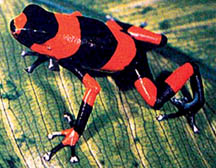
The baby frogs or tadpoles live on moss and insect eggs, growing
limbs and becoming adult frogs...
More facts on these deadly frogs
* A Cuban frog, Sminthillus limbatus which is closely related to the
Golden Arrow-poison frog, is considered to be the smallest frog in the
world, measuring only 8-12 mm, that is less than 0.5 inches!
* It has been discovered recently that an extract from the skin of
arrow-poison frogs could block pain 200 times more effectively than
morphin.
* It takes about 12 weeks for a Blue arrow poison tadpole to turn
into a frog.
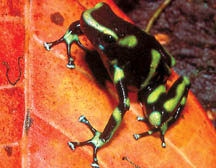
* The Marbled milk frog and Thai tree frog are also relatives of the
arrow-poison frogs.
* One frog carries enough poison to kill about 100 people.
* Called the champion poisoners, the tiny kokoi frogs, as little as
one gram, are lethal.
* The young frogs are defenceless because they do not have any
poison. They are brownish black in colour.
* Very few frogs look after their young, once hatched, and among
those who do, are the red and blue arrow-poison frogs who even produce
infertile eggs to feed the tadpoles.
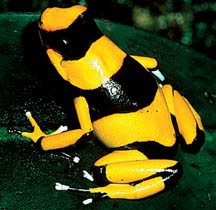
* Because of their lethal defence system, these frogs are able to
live trouble free lives. Their existence is threatened purely by
deforestation of rainforests.
* These frogs are social frogs.
* They are so bold because of the defence system, that they even sing
out in the open.
* The eggs are laid on a jelly-like mass that is guarded by a parent
or visited and regularly moistened.
We'll bring you more information on different types of frogs in our
future issues. |


